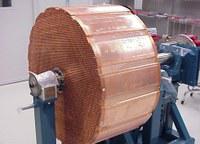The international team of researchers that has been smashing high-energy protons together inside the Large Hadron Collider (LHC) to re-create the conditions at the time of the Big Bang announced new evidence today pointing to an observation of the Higgs boson.
The Higgs boson is a hypothetical massive elementary particle that is predicted to exist by the Standard Model of particle physics. The Standard Model has been the basis of particle physics for more than 30 years and describes the forces between particles of matter. The Higgs boson is the missing ingredient in the model that has been hypothesized to explain the existence of mass in the universe.
At a joint seminar held in Geneva today, scientists from the LHC’s two main experiments: ATLAS and CMS met to report results of the search for the Higgs boson from data collected over the last two years. Neither team knew the other’s results in advance. While not 100% conclusive, the evidence clearly points to an observation of the Higgs boson.
“While we are not able to say with certainty that what we’ve seen is the Higgs boson, it is beginning to look like there is something really there” said William Trischuk , a U of T member of the ATLAS team and Director of the Institute of Particle Physics. “We’re further ahead than we expected to be at this point because the collider has delivered five times more data than expected this year.”
The results presented today rule out the existence of the Higgs boson for masses outside a window between 115 and 130 GeV. (1 GeV is the mass of a proton, so the Higgs is somewhere between 115 and 130 times heavier than a proton.) Within the remaining small window, both the ATLAS and CMS experiments showed tantalizing hints of Higgs-like signals near 125 GeV. Even combining the results from the two experiments is not conclusive enough to claim discovery of the Higgs boson. The scientists anticipate collecting four times as much data in 2012 to get more definitive results.
Robert Orr , the founder of the U of T team said: “While the Higgs boson is postulated to generate the masses of elementary particles, it doesn’t predict why they have the masses they do. That, to me, is the real issue. Observing the Higgs boson is the beginning, not the end.”
The U of T high-energy physicists, along with their 2,500 ATLAS colleagues from 35 countries, have played a key role in the hunt for the Higgs. The ATLAS detector, key components of which were built at U of T, was designed to search for new particles in the highest mass collisions of high-energy proton collisions in the LHC.
The group of 30 U of T researchers, including 16 graduate students, has used the SciNet super-computing resources at U of T to sift through the ATLAS data to identify collisions containing Higgs boson candidates.
“An important aspect of this kind of research is that the ingenious contributions from ATLAS physicists around the world, including several by younger researchers in Toronto must come together to make such exciting results possible,” said U of T’s Pierre Savard , the Canadian ATLAS physics coordinator and a member of the scientific staff at TRIUMF, Canada’s National Laboratory for Particle and Nuclear Physics.
The LHC, the world’s largest and highest-energy particle accelerator, was launched on March 27, 2010. Located in Geneva, the collider has a circumference of 27 kilometres and is 100 metres underground.
The U of T faculty members involved in the project are David Bailey , Peter Krieger , Robert Orr , Pierre Savard , Pekka Sinervo , William Trischuk and Richard Teuscher .

